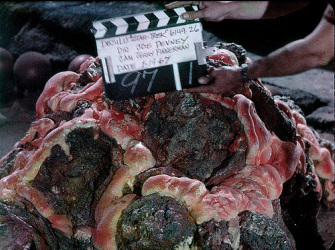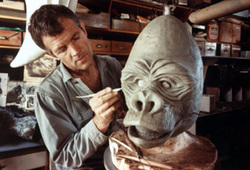TRUE STAR TREK® TRIVIA
Do you know why the cavern floors on planet Janus IV (in Star Trek: TOS episode "The Devil in the Dark") are so flat and smooth?

In the classic Star Trek episode “The Devil in the Dark,” a creature known as the Horta bores tunnels through solid rock and reins havoc on a mining colony deep under the surface of planet Janus VI. Matt Jefferies, Star Trek’s talented set designer, worked hard to create the catacombs that take us deeper and deeper into the depths of the inhospitable world. The rough-blasted walls and ceilings of the caves and tunnels are beautifully realized. But what of the ground beneath? It seems a glaring flaw that the lower surface is clearly smooth and shiny stage flooring.
Gene Roddenberry took notice when he watched the episode for the first time on NBC and, days later, on March 9, 1967, wrote a memo to his producer, Gene Coon, saying, “This could have used some painting mottled effect, as it seemed awfully shiny and new and stage-surface-like for an underground mining installation. It took away from the reality, which the rough-blasted walls gave us.”
So why would talented men such as Coon and Jefferies, and Star Trek associate producer in charge of production, Robert H. Justman, allow for the reality of the episode to be suspended with flooring that was so clearly “stage-surface-like”?
Gene Roddenberry took notice when he watched the episode for the first time on NBC and, days later, on March 9, 1967, wrote a memo to his producer, Gene Coon, saying, “This could have used some painting mottled effect, as it seemed awfully shiny and new and stage-surface-like for an underground mining installation. It took away from the reality, which the rough-blasted walls gave us.”
So why would talented men such as Coon and Jefferies, and Star Trek associate producer in charge of production, Robert H. Justman, allow for the reality of the episode to be suspended with flooring that was so clearly “stage-surface-like”?

Answer.
Blame Janos Prohaska -- the designer and stunt performer inside of the glob-like Horta costume -- for those smooth floors.
Bjo Trimble, who was visiting the set as Roddenberry’s guests, explained “It would have been difficult for Janos to navigate the rocky floor. He stood about six-four, but he could contort himself into the most amazing positions. He was down on his hands and knees, so they needed it to be a smooth floor; he was in a bad enough position as it was.”
Robert Justman concurred, saying, “That was a seven day production. We spent six of the seven days in those tunnels and catacombs. That meant the man in the Horta costume spent six of those seven days on his hands and knees. Correction: elbows and knees – crawling, turning, pouncing, scurrying away. And we were fond of the man in the Horta costume. We hoped to see him be able to stand up and walk away from this job.”
Justman added, “There were many other creatures scurrying about – production people, camera operators, actors, each a potential lawsuit should one fall and break one’s neck. And this is why stage floors are usually flat. You may recall that the Horta turned out not to be a beast after all. The real beast is the inherent short schedules of television production. If ‘The Devil in the Dark’ were a feature film, we would have been in those tunnels for several weeks instead of several days. Speaking only for myself, I was happy we were not in those tunnels for several weeks. It was not an easy production.”
And now you know one of many interesting tidbits concerning the making of “The Devil in the Dark.”.
Know all there is about the making of this classic episode, and all the original Star Trek episodes, by reading "These are the Voyages – TOS," to be published in three volumes (one for each season) by Jacobs Brown Press.
Blame Janos Prohaska -- the designer and stunt performer inside of the glob-like Horta costume -- for those smooth floors.
Bjo Trimble, who was visiting the set as Roddenberry’s guests, explained “It would have been difficult for Janos to navigate the rocky floor. He stood about six-four, but he could contort himself into the most amazing positions. He was down on his hands and knees, so they needed it to be a smooth floor; he was in a bad enough position as it was.”
Robert Justman concurred, saying, “That was a seven day production. We spent six of the seven days in those tunnels and catacombs. That meant the man in the Horta costume spent six of those seven days on his hands and knees. Correction: elbows and knees – crawling, turning, pouncing, scurrying away. And we were fond of the man in the Horta costume. We hoped to see him be able to stand up and walk away from this job.”
Justman added, “There were many other creatures scurrying about – production people, camera operators, actors, each a potential lawsuit should one fall and break one’s neck. And this is why stage floors are usually flat. You may recall that the Horta turned out not to be a beast after all. The real beast is the inherent short schedules of television production. If ‘The Devil in the Dark’ were a feature film, we would have been in those tunnels for several weeks instead of several days. Speaking only for myself, I was happy we were not in those tunnels for several weeks. It was not an easy production.”
And now you know one of many interesting tidbits concerning the making of “The Devil in the Dark.”.
Know all there is about the making of this classic episode, and all the original Star Trek episodes, by reading "These are the Voyages – TOS," to be published in three volumes (one for each season) by Jacobs Brown Press.

